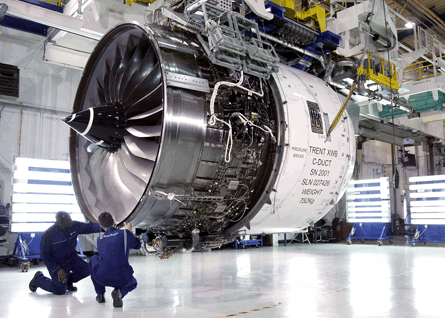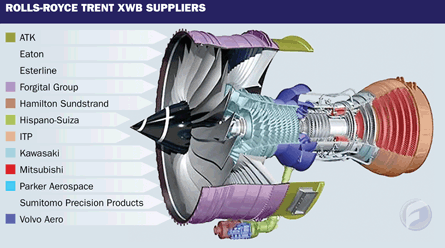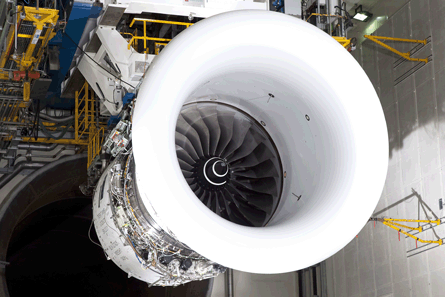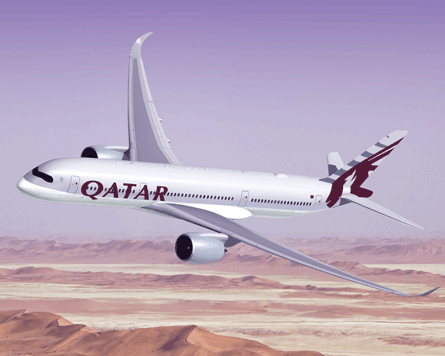Rolls-Royce's Trent XWB programme team reaches the show in buoyant mood after completing the Airbus A350 powerplant's first run on 17 June.
"It meets a commitment we gave to Airbus four years ago," says Trent XWB programme director Chris Cholerton. "The programme is on track. The attributes of the engine are also on track - we're feeling good about the status of the performance, weight, emissions and noise."
As the sole engine option for Airbus's flagship long-range widebody twin - still three years away from its planned 2013 service-entry date - the UK manufacturer has collected orders for more than 1,000 Trent XWBs, destined to power the 535 A350s already residing in Airbus's firm orderbook. The customer tally going into the show stands at 33.
The ramp-up of A350 production will see R-R more than double its overall Trent turbofan production rate over the next five years, raising the stakes as the Trent XWB enters its critical ground and subsequent flight-test phases. Trent XWB production will also ramp up faster than any previous Trent, to reach an expected rate of close to one engine a day.
 |
|---|
© Rolls-Royce |
A watchword for the programme is "maturity", with the engine-maker promising airlines a zero in-flight shutdown rate from day one of revenue-earning operations.
To this end "we've invested a lot more early in the programme", says Cholerton. "We've done more design hours earlier, doing a greater scope of analysis, and we also want to get more engines to test more quickly than we have on previous programmes to deliver maturity. We aim to bring seven engines to test by early next year," he adds.
"The objective is to start accumulating cycles and hours on the engine at a higher rate than we have previously, to learn more about the engine early in the programme and make any design optimisations and changes we need to make so we get a mature product ahead of flight test and service."
More manufacturing engineers have also been dedicated to the XWB earlier than on previous Trent programmes, with the aim of ensuring that parts can be made to consistently high standards of quality and reliability. These parts are also being assessed for known service-risks identified on other Trents, and also for risks associated with the introduction of new technologies, to minimise maintenance and overall lifecycle costs.
"We follow two different approaches," says Trent XWB chief engineer Chris Young. "We look at anything that's ever happened in service - any failures, wear-out or deterioration mechanisms and we assess whether any of our components might be subject to similar mechanisms.
 |
|---|
"In addition to that, we look at any new parts that we've designed that have no service pedigree and ask: how could these wear out or fail or have issues in service? We assess all of those potential causes and then we either design them out, or if we think we've designed them out we do some testing in the development programme to ensure that we've designed them out," says Young.
The worldwide Trent fleet, powering A330s, A340s, A380s and Boeing 777s, has to date accumulated around 40 million flight hours, and this total is forecast to have reached 60 million by the time the Trent XWB enters service in 2013.
Despite ever-increasing computer processing speeds improving R-R's computational fluid dynamics capabilities, there is still a major role for testing, says Cholerton. About seven times the computing capacity available for previous engine programmes has been deployed in the design process for the Trent XWB.
"The CFD is very, very good, but it tends to need calibration," says Young.
The Trent XWB is assembled from some 18,000 core parts, fabricated in 16 R-R plants and sourced from the programme's 12 risk revenue-sharing partners and 88 external suppliers. Cholerton says around one-third of the engine's parts by value are yet to be contracted out.
At 3m (118in), the Trent XWB's fan diameter is 50mm (2in) greater than that of the Trent 900, which powers the A380, although the 2.84m-diameter Trent 800 for the Boeing 777 will remain the most powerful engine yet produced by R-R. Incremental technology advances have enabled the Trent XWB to continue the trend of achieving higher bypass ratios as temperature and pressure ratios in the core increase.
The XWB is the first Trent variant for an Airbus aircraft to feature a fan case pylon mounting. It also introduces to the Trent family a two-stage intermediate-pressure (IP) turbine design.
The 17 June first-run milestone saw the engine run at idle with the primary aim of "getting the instrumentation to work", says Young. "We had one minor oil leak that we just needed to fix overnight. Now we're in that phase of expanding the envelope. We usually get a couple of runs per day," he says.
 |
|---|
© Rolls-Royce |
The first Trent XWB in the four-year-old "58 testbed" at R-R's Derby factory was expected to have accumulated in excess of 30 runs prior to the show. The second and third test engines are in final assembly and the modules for the fourth and fifth are being kitted out. Deliveries of production engines are on target to begin in late-2012.
The Trent XWB will be produced using the "lean" build-line concept being introduced for the 787's Trent 1000, which features separate moving lines for assembly of fan cases and engine cores. R-R therefore aims to prove the effectiveness of the concept in Trent 1000 assembly, before the XWB enters series production.
Flight trials of the Trent XWB will be conducted aboard Airbus's A380 test aircraft from Toulouse starting in mid-2011, and are expected to encompass around 175 flight hours and take about six months to complete, leading to engine certification at the end of that year. The Trent XWB's nacelle is being supplied by Goodrich, under contract to Airbus.
The current schedule calls for the A350-900 to make its maiden flight in mid-2012. The lead A350-900 and the -800 shrink variant - due to enter service in mid-2013 and mid-2014, respectively - will be powered by the baseline 84,000lb-thrust (374kN) Trent XWB (de-rated to 79,000lb or 75,000lb for the smaller aircraft).
A "hot and high" optimised version of the 79,000lb-thrust engine is available for the -800, known as the Trent XWB-79B, which provides the performance of the 84,000lb version for take-off under high-temperature conditions to preserve the aircraft's payload capability. This option will be of particular use to Doha-based A350 launch customer Qatar Airways.
 |
|---|
© Tim Bicheno-Brown/Flightglobal |
The -1000 stretch of the airframe requires some engine design changes to achieve a thrust rating of 93,000lb without compromising lifecycle costs. The growth variant is scheduled to enter testing in early-2013, ahead of service entry at the end of 2015.
"We don't freeze the configuration of the -93 until mid-2011," says Cholerton. A "key technology enabler" for this development is the R-R's latest, £95 million ($143 million) EFE (environmentally friendly engine), Trent 1000-based high-temperature technology demonstrator programme, he adds.
The 93,000lb-thrust variant will also draw on technology developed as part of R-R's two shaft E3E (efficiency, environment, economy) project, which is being partly funded by the German government. The E3E core was recently run for 40h at Stuttgart University's altitude test facility.
The Trent XWB-93 retains the fan diameter of its less powerful siblings, but the fan system will be strengthened and spun faster because "at take-off we want to take more flow through the fan", says Young, although "the aerodynamics have not changed".
Modifications will also be introduced to "increase the capability of the core to run at higher temperatures", says Young. These include changes to the IP and high-pressure turbines to make use of upgraded materials. The design of the HP turbine is being modified and thermal barrier coatings in the IPT will be upgraded.
"We'll make the final technology downselects [for the -93] in mid-2011," says Young.
On noise and emissions, Cholerton says R-R is on track to meet guarantees given to customers. The Trent XWB's emissions performance has been validated following latest "phase five" combustor and full-engine rig testing.
Airbus and R-R have agreed that the noise objective for the A350-800/900 is to meet London Heathrow Airport's stringent QC1 standard for departures and QC0.5 for arrivals, while the -1000 will be QC2 and QC1 compliant for departures and arrivals, respectively. A programme to develop a low-noise engine bleed valve to further reduce approach noise is under way.
Source: Flight International



















